-
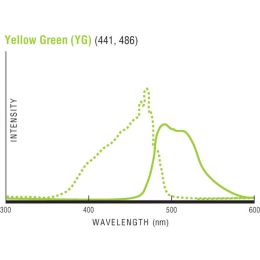 Streptavidin Fluoresbrite® YG Microspheres, 6.0µmCatalog Number 24157
Streptavidin Fluoresbrite® YG Microspheres, 6.0µmCatalog Number 24157Polysciences' streptavidin coated beads can be used in conjunction with a biotinylated ligand, antibody, DNA or RNA to form a bridge to the microsphere, providing the simple addition of a solid support. The streptavidin-biotin bond strength approaches that of a covalent bond, with an association constant (Ka 10^15 Mol-1) in an aqueous solution. This makes the bond not only essentially irreversible, but also supplies an interaction of high affinity and specificity.
-
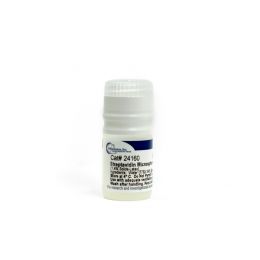 Streptavidin Microspheres, 2.0µmCatalog Number 24160
Streptavidin Microspheres, 2.0µmCatalog Number 24160Polysciences' streptavidin coated beads can be used in conjunction with a biotinylated ligand, antibody, DNA or RNA to form a bridge to the microsphere, providing the simple addition of a solid support. The streptavidin-biotin bond strength approaches that of a covalent bond, with an association constant (Ka 10^15 Mol-1) in an aqueous solution. This makes the bond not only essentially irreversible, but also supplies an interaction of high affinitiy and specificity.
-
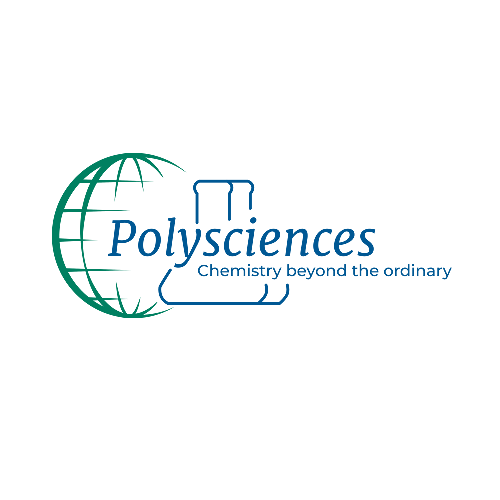 Streptavidin Microspheres, 1.0µmCatalog Number 24162
Streptavidin Microspheres, 1.0µmCatalog Number 24162Polysciences' streptavidin coated beads can be used in conjunction with a biotinylated ligand, antibody, DNA or RNA to form a bridge to the microsphere, providing the simple addition of a solid support. The streptavidin-biotin bond strength approaches that of a covalent bond, with an association constant (Ka 10^15 Mol-1) in an aqueous solution. This makes the bond not only essentially irreversible, but also supplies an interaction of high affinitiy and specificity. 1µm particles packaged as 1.25% solids in aqueous suspension.
-
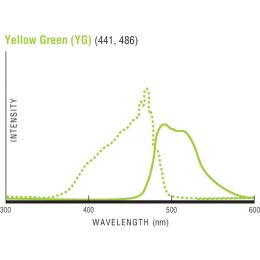 Streptavidin Fluoresbrite® YG Microspheres, 1.0µmCatalog Number 24161
Streptavidin Fluoresbrite® YG Microspheres, 1.0µmCatalog Number 24161Polysciences' streptavidin coated beads can be used in conjunction with a biotinylated ligand, antibody, DNA or RNA to form a bridge to the microsphere, providing the simple addition of a solid support. The streptavidin-biotin bond strength approaches that of a covalent bond, with an association constant (Ka 10^15 Mol-1) in an aqueous solution. This makes the bond not only essentially irreversible, but also supplies an interaction of high affinitiy and specificity.
-
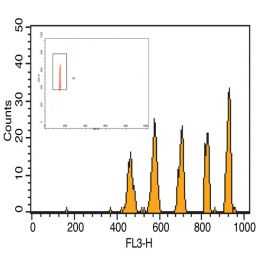 QuantumPlex™ SP Streptavidin 4.4µmCatalog Number BLI214A
QuantumPlex™ SP Streptavidin 4.4µmCatalog Number BLI214AThe microsphere populations in the QuantumPlex™five-bead kits are encoded with different intensities of Starfire Red™, and microspheres in our ten-bead kits are distinguished by both fluorescence intensity and size. Starfire Red™ is a fluorescent dye with unique characteristics that make it ideal for multiplexing applications. The dye's broad excitation band allows it to be excited at a number of wavelengths, and it emits in the FL3 channel (685nm) with very little carry-over into FL1 or FL2, leaving othe detectors available for determination of positive binding events via common reporters such as FITC and PE.
-
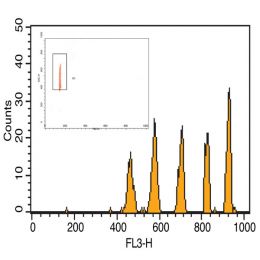 QuantumPlex™ Streptavidin 4.4µmCatalog Number BLI215A
QuantumPlex™ Streptavidin 4.4µmCatalog Number BLI215AThe microsphere populations in the QuantumPlex™five-bead kits are encoded with different intensities of Starfire Red™, and microspheres in our ten-bead kits are distinguished by both fluorescence intensity and size. Starfire Red™ is a fluorescent dye with unique characteristics that make it ideal for multiplexing applications. The dye's broad excitation band allows it to be excited at a number of wavelengths, and it emits in the FL3 channel (685nm) with very little carry-over into FL1 or FL2, leaving othe detectors available for determination of positive binding events via common reporters such as FITC and PE.
-
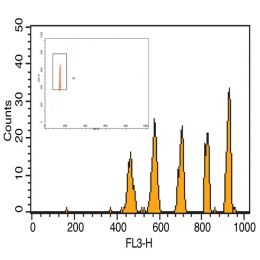 QuantumPlex™ SP Streptavidin 5.5µmCatalog Number BLI217A
QuantumPlex™ SP Streptavidin 5.5µmCatalog Number BLI217AThe microsphere populations in the QuantumPlex™five-bead kits are encoded with different intensities of Starfire Red™, and microspheres in our ten-bead kits are distinguished by both fluorescence intensity and size. Starfire Red™ is a fluorescent dye with unique characteristics that make it ideal for multiplexing applications. The dye's broad excitation band allows it to be excited at a number of wavelengths, and it emits in the FL3 channel (685nm) with very little carry-over into FL1 or FL2, leaving othe detectors available for determination of positive binding events via common reporters such as FITC and PE.
-
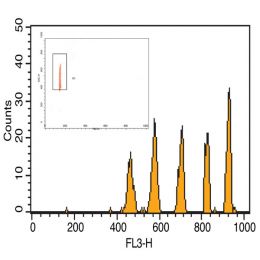 QuantumPlex™ Streptavidin 5.5µmCatalog Number BLI218A
QuantumPlex™ Streptavidin 5.5µmCatalog Number BLI218AThe microsphere populations in the QuantumPlex™five-bead kits are encoded with different intensities of Starfire Red™, and microspheres in our ten-bead kits are distinguished by both fluorescence intensity and size. Starfire Red™ is a fluorescent dye with unique characteristics that make it ideal for multiplexing applications. The dye's broad excitation band allows it to be excited at a number of wavelengths, and it emits in the FL3 channel (685nm) with very little carry-over into FL1 or FL2, leaving othe detectors available for determination of positive binding events via common reporters such as FITC and PE.
-
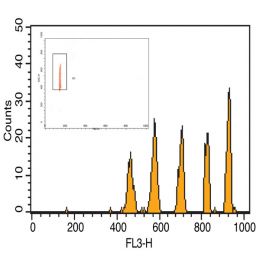 QuantumPlex™ Streptavidin 4.4 & 5.5µmCatalog Number BLI219A
QuantumPlex™ Streptavidin 4.4 & 5.5µmCatalog Number BLI219AThe microsphere populations in the QuantumPlex™five-bead kits are encoded with different intensities of Starfire Red™, and microspheres in our ten-bead kits are distinguished by both fluorescence intensity and size. Starfire Red™ is a fluorescent dye with unique characteristics that make it ideal for multiplexing applications. The dye's broad excitation band allows it to be excited at a number of wavelengths, and it emits in the FL3 channel (685nm) with very little carry-over into FL1 or FL2, leaving othe detectors available for determination of positive binding events via common reporters such as FITC and PE.
-
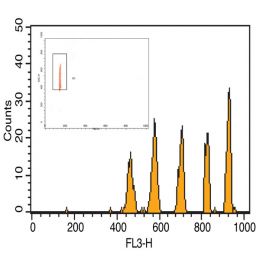 QuantumPlex™M Streptavidin ~6µm MagneticCatalog Number BLI252A
QuantumPlex™M Streptavidin ~6µm MagneticCatalog Number BLI252AThe microsphere populations in the QuantumPlex™M five-bead kits are encoded with different intensities of Starfire Red™. Starfire Red™ is a fluorescent dye with unique characteristics that make it ideal for multiplexing applications. The dye's broad excitation band allows it to be excited at a number of wavelengths, and it emits in the FL3 channel (685nm) with very little carry-over into FL1 or FL2, leaving othe detectors available for determination of positive binding events via common reporters such as FITC and PE.
-
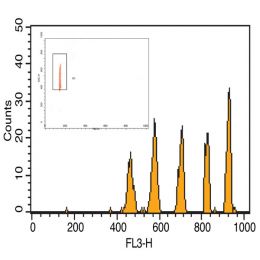 QuantumPlex™M SP Streptavidin ~6µm MagneticCatalog Number BLI253A
QuantumPlex™M SP Streptavidin ~6µm MagneticCatalog Number BLI253AThe microsphere populations in the QuantumPlex™M five-bead kits are encoded with different intensities of Starfire Red™. Starfire Red™ is a fluorescent dye with unique characteristics that make it ideal for multiplexing applications. The dye's broad excitation band allows it to be excited at a number of wavelengths, and it emits in the FL3 channel (685nm) with very little carry-over into FL1 or FL2, leaving othe detectors available for determination of positive binding events via common reporters such as FITC and PE.
-
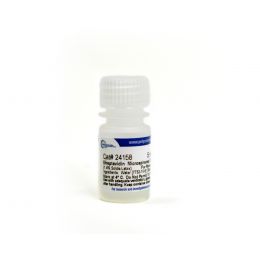 Streptavidin Microspheres, 6.0µmCatalog Number 24158
Streptavidin Microspheres, 6.0µmCatalog Number 24158Polysciences' streptavidin coated beads can be used in conjunction with a biotinylated ligand, antibody, DNA or RNA to form a bridge to the microsphere, providing the simple addition of a solid support. The streptavidin-biotin bond strength approaches that of a covalent bond, with an association constant (Ka 10^15 Mol-1) in an aqueous solution. This makes the bond not only essentially irreversible, but also supplies an interaction of high affinitiy and specificity.
Streptavidin Microspheres
